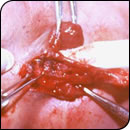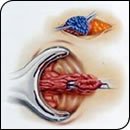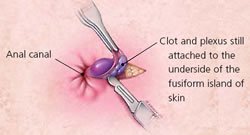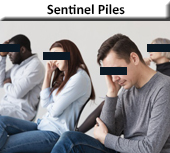Hemorrhoidectomy for Thrombosed External Hemorrhoids
External hemorrhoids represent distended vascular tissue in the anal canal distal to the dentate line. Persons with thrombosed external hemorrhoids usually present with pain on standing, sitting or defecating. Acutely tender, thrombosed external hemorrhoids can be surgically removed if encountered within the first 72 hours after onset. Hemorrhoidectomy is performed through an elliptic incision over the site of thrombosis with removal of the entire diseased hemorrhoidal plexus in one piece. Caution must be exercised to avoid cutting into the muscle sphincter below the hemorrhoidal vessels. Infection after suture closure is rare secondary to the rich vascular network in the anal area. Stool softeners must be prescribed postoperatively to help prevent tearing at the suture line. Training and experience in general and skin surgery are necessary before the physician attempts this procedure unsupervised.
External hemorrhoids usually develop over time and may result from straining with stools, childbirth, lengthy car trips or prolonged sitting, constipation or diarrhea. External hemorrhoids represent distended vascular tissue in the anal canal distal (outside) to the dentate line (the junction between the rectal mucosa and the specialized skin of the anal canal, called the anoderm). External hemorrhoids are covered by anoderm and perianal skin richly innervated with somatic pain fibers. Diseases affecting the anal canal or the external hemorrhoidal vessels can be extremely painful.
External hemorrhoids often develop in healthy young persons and may suddenly become thrombosed. Persons with thrombosed external hemorrhoids usually present with pain on standing, sitting or defecating. The thrombosis is slowly absorbed by the body during the course of several weeks. A resolving thrombosis may erode through the skin and produce bleeding or drainage.
Acutely swollen and tender thrombosed external hemorrhoids can be surgically removed during the first 72 hours after onset. After 72 hours, the discomfort of the procedure often exceeds the relief provided by the surgery. Some patients still chose to undergo late surgery, although they should understand that without surgery the hemorrhoid will eventually become fibrosed and resolve over a period of days to weeks.
An elliptic incision can be made over the thrombosis, and the clot and the entire diseased hemorrhoidal plexus can be removed in one piece. Although the site can be left open, many physicians prefer to place subcutaneous sutures to limit postoperative pain and bleeding. Suturing in this area, historically, has been avoided because of fear of complications, yet the rich vascular network in the anal tissues usually provides for rapid healing.
Simple incision over a thrombus after the administration of local anesthesia can be performed to remove the clot, but this procedure has been associated with a significant rate of rethrombosis. Many experts now recommend excision of the entire thrombosis and the external hemorrhoidal vessels beneath. This procedure is more extensive than simple incision but usually yields a better outcome.
Methods & Materials
Patient Preparation
The patient should be undressed from the waist down and draped. An absorbent pad is placed beneath the patient. The patient can be seated on the examination table to speak with the physician. At the start of the procedure, the patient is rolled to the left side in the left lateral decubitus position. The right hip and knee are flexed, and a drape covers the patient's waist and legs.
Equipments
Nonsterile Tray for Anoscopy and Anesthesia
Place the following items on a nonsterile drape covering a Mayo stand
- Nonsterile gloves
- 1 inch of 4 X 4 gauze
- 4X4 gauze soaked with povidone-iodine solution
- 1 inch of 2 percent lidocaine jelly (Xylo-caine) placed on the corner of the drape
- Ive's anoscope
- Mask (if desired)
- 10 – ml syringe filled with 1 percent lidocaine with a 25 – gauge, 1 ¼ – inch needle
Sterile Tray for the Procedure
Place the following items on a sterile drape covering a Mayo stand :
- Sterile gloves
- 2 inches of sterile 4X4 gauze
- 3 hemostats (mosquito clamps)
- No. 15 scalpel blade and blade handle
- Needle holder
- Adson forceps with teeth
- Iris scissors (for cutting sutures)
- Mayo or tissue-cutting scissors
- AUis clamp for holding tissue
- 4-0 Vicryl suture
Procedure Description
- 1. The patient is placed in the left lateral decubitus position. The perianal skin is visualized by having an assistant separate the buttocks or by taping the buttocks apart. The anal canal can be visualized using an Ive's anoscope coated with 2 percent lidocaine jelly. The extent of the hemorrhoidal disease should be assessed and coexisting anal pathology excluded before initiating the procedure. Alternately, anoscopy can be performed after anesthetic administration (injection) when the thrombosed hemorrhoids are exquisitely tender.
- 2. The perianal skin and anal canal are cleansed with povidone-iodine solution. The base of the hemorrhoid is infiltrated with atleast 5 ml of 1 percent lidocaine, using a 25 – gauge, 1 ¼ – inch needle. Avoid making multiple needle sticks in the anal tissues because the puncture sites can bleed after needle removal. Warn the patient about impending needle insertion into the tender tissues.
- 3. A fusiform (elliptic) excision is made into the anal skin overlying the thrombosis. It is preferable to make a radial incision extending out from the anal canal if the entire hemorrhoid plexus is removed; some physicians prefer a circumferential incision that exposes more clots by crossing over more of the hemorrhoidal sinusoids beneath (Figure 1). Vigorous bleeding may accompany this incisionand can be controlled with direct pressure or electrocautery, if needed.
- 4. A clamp can be placed on the fusiformskin island and traction applied to the skin toreveal the hemorrhoid below (Figure 2). Theentire hemorrhoid is sharply excised with ano. 15 blade or scissors. The entire hemorrhoidal plexus usually can be removed as one piece attached to the fusiform skin island. Avoid cutting into the muscle sphincter below the hemorrhoidal vessels.
Figure 1 : The circumferential incision of a thrombosed external hemorrhoid opens across the hemorrhoidal plexus, making removal of clots from the vessel easier
Figure 2 : The fusiform island of skin is grasped and elevated. Sharp excision of the clot and hemorrhoidal plexus of vessels in the subcutaneous tissues is performed.
5. Once the hemorrhoidal plexus and clot have been removed, the base of the wound is examined for residual small clots. Additional hemorrhoidal tissue or clots can be sharply excised. Some physicians chose to close the deep wound with subcutaneous, absorbable, buried 4-0 Vicryl sutures to avoid significant postprocedure bleeding. The sutures should be completely subcutaneous and not penetrate external to the anal skin. Wound closure can reduce bleeding and discomfort at the surgical site. Alternatively, some physicians prefer to leave the wound open.
6. The wound should be inspected for adequate hemostasis. If epinephrine is used to anesthetize the wound and the wound is unsutured, late bleeding (up to several hours postprocedure) can develop once the effect of the epinephrine wears off. Topical antibiotic ointment is applied to the surgical site, and 1 inch of 4 x 4 gauze is applied over the site between the buttocks. The patient can be given additional gauze for use at home.
Follow-Up
Most physicians believe that the throm-bosed plexus of vessels should not be sent for histologic evaluation, because analysis of the tissue generally fails to yield useful additionalinformation. If solid tumors or unusual tissue characteristics are discovered at the time of surgery, histologic analysis of the tissue may be warranted.
The patient should have a follow-up visit at six weeks postprocedure. If extensive coexisting internal hemorrhoids are noted, these can be managed with infrared coagulation or another destructive modality. Some physicians also recommend colon examination for all patients with hemorrhoids. The medical literature provides conflicting recommendations on the need for colon evaluation, but if flexible sigmoidoscopy is performed, it should occur between six to 12 weeks after the original surgery.
Procedure Pitfalls / Complication
- The Patient Left the Office with the Wound Dry, but Returned Later with Extensive Bleeding. Hemorrhoidal plexuses include both arterial and venous vessels. When surgery is performed, the cut arterioles may spasm, and bleeding ceases. If lidocaine with epinephrine is used and the surgical wound is not closed with suture, the patient can develop significant bleeding when the effect of the epinephrine wears off. Some physicians advocate no epinephrine in the anesthetic and the use of suture to close the wound to limit the risk of late bleeding.
- Excessive Scarring or Anal Stenosis Developed After the Surgery. The development of anal stenosis is a rare, but definite, complication associated with hemorrhoid surgery that can be reduced by avoiding circumferential procedures on all sides of the anal canal. Performing extensive cautery can limit bleeding during the procedure but also can induce extensive scarring and should be avoided
- Concern About the Risk of Infection if Wound Is Surgically Closed. Infection after suture closure is an unusual occurrence, partly because of the rich vascular network in the anal area. Several studies have confirmed the safety of suture closure, and discomfort and bleeding complications may be reduced by this technique. Prophylactic antibiotics are prescribed by some physicians for possible post infection following suture closure.
- Patient Complains That Anoscopy Is Too Uncomfortable Before Hemorrhoid Surgery. Extensive inspection of the perianal tissues is recommended to exclude coexisting disease. Infectious complications of the excision procedure may relate to unrecognized infectious processes, such as perianal abscesses. Persisting pain could relate to a coexisting fissure. The inspection of the anal tissues should not be deferred, and anoscopy can be performed after administration of the anesthetic to make it more tolerable for the patient.
- Subcuticular Wound Closure Is Very Difficult at the Anus. Suture placement is difficult in the anus because of the narrow surgical field and because sutures do not hold well in the tissues below the anoderm. Taking adequate bites of tissue with each pass of the suture needle and placing multiple, interrupted, buried sutures can ensure proper closure of the wound. The suture should be sub-cuticular and not protrude through the anoderm.
- The Patient Notices a Tearing Sensation and Bleeding During the First Week After the Procedure. Passage of hard stool can easily tear the suture line. The need for soft stools must be emphasized to the patient. Multiple modalities can be used to soften the stools, such as stool softeners, stool-bulking agents and increased daily consumption of fluids. Even with soft stools, however, it is not unusual for some tearing to occur at the suture line.
Physician Training
Physicians with proper surgical skills can master this procedure. Extensive training and experience in general and skin surgery may be needed before attempting this procedure unsupervised. The bleeding that occurs during the procedure may frighten novice surgeons. The complications of the procedure should be respected, and patients can be referred to more experienced physicians if a comfort level and adequate experience are lacking; however, the basic skills needed to perform this procedure are not unlike those for the fusiform excisional biopsy commonly performed for removal of skin lesions.
Nursing Instructions
Patient Preparation
The patient is asked to undress from the waist down and given a drape to cover the waist and legs. The patient can be left seated on the examination table to speak with the physician. At the start of the procedure, the patient is rolled onto the left side and into the left lateral decubitus position. The knees are bent, and a drape covers the waist and legs. An absorbent pad is placed under the buttocks and the anal area.
Nonsterile Tray for Anoscopy and Anesthesia
Place the following items on a nonsterile drape covering a Mayo stand
- Nonsterile gloves
- 1 inch of 4 X 4 gauze
- 4X4 gauze soaked with povidone-iodine solution
- 1 inch of 2 percent lidocaine jelly (Xylo-caine) placed on the corner of the drape
- Ive's anoscope
- Mask (if desired)
- 10 – ml syringe filled with 1 percent lidocaine with a 25 – gauge, 1 ¼ – inch needle
Sterile Tray for the Procedure
Place the following items on a sterile drape covering a Mayo stand :
- Sterile gloves
- 2 inches of sterile 4X4 gauze
- 3 hemostats (mosquito clamps)
- No. 15 scalpel blade and blade handle
- Needle holder
- Adson forceps with teeth
- Iris scissors (for cutting sutures)
- Mayo or tissue-cutting scissors
- AUis clamp for holding tissue
- 4-0 Vicryl suture
Postprocedure Nursing Instructions
The anal area and buttocks can be cleansed with sterile saline or a gauze dampened with water to wipe away any blood or drainage. Soiled gauze and the absorbent pad are disposed of in an appropriate bio-hazard waste container.
Antibiotic ointment is applied to the surgical site, and 1 inch of clean gauze is placed over the site between the buttocks.
The patient may need assistance with placement of underwear while maintaining the gauze between the buttocks.
Disposable needles and suture needles are disposed of in appropriate sharps containers.
The instruments should be scrubbed, washed, rinsed and dried. The instruments should be placed in a clear sterilization packet, either individually or as a tray, and sterilized in the autoclave.
























